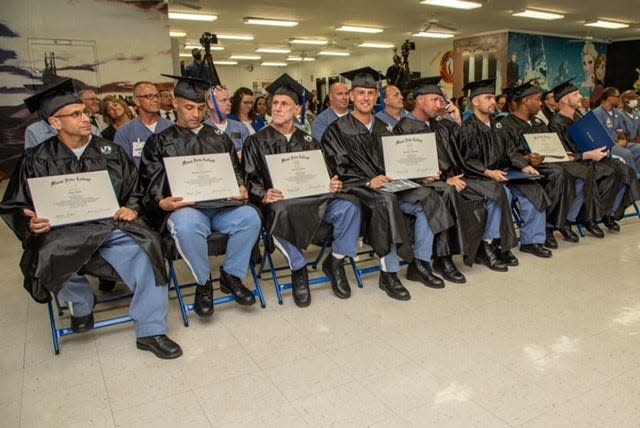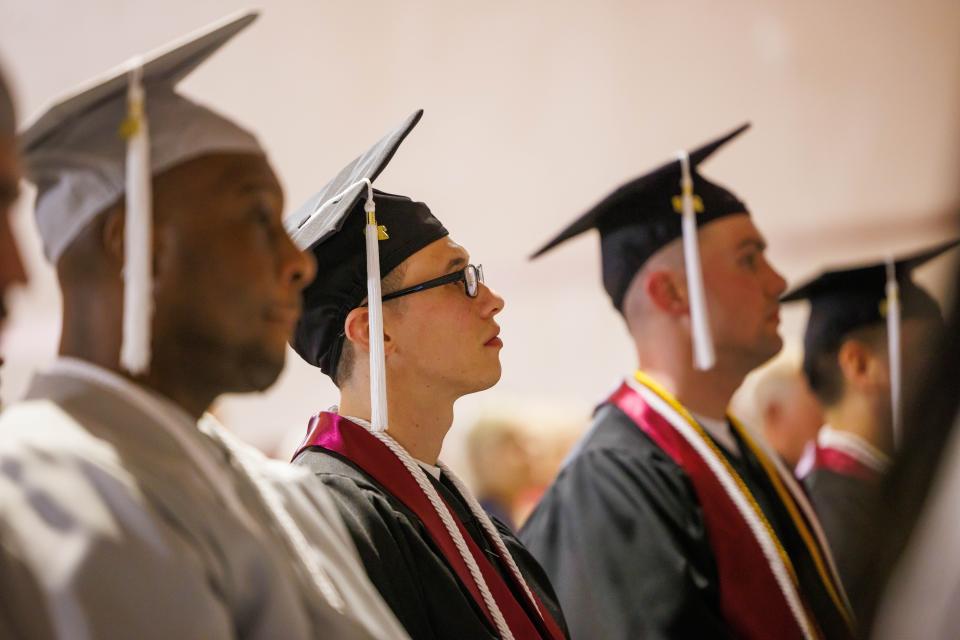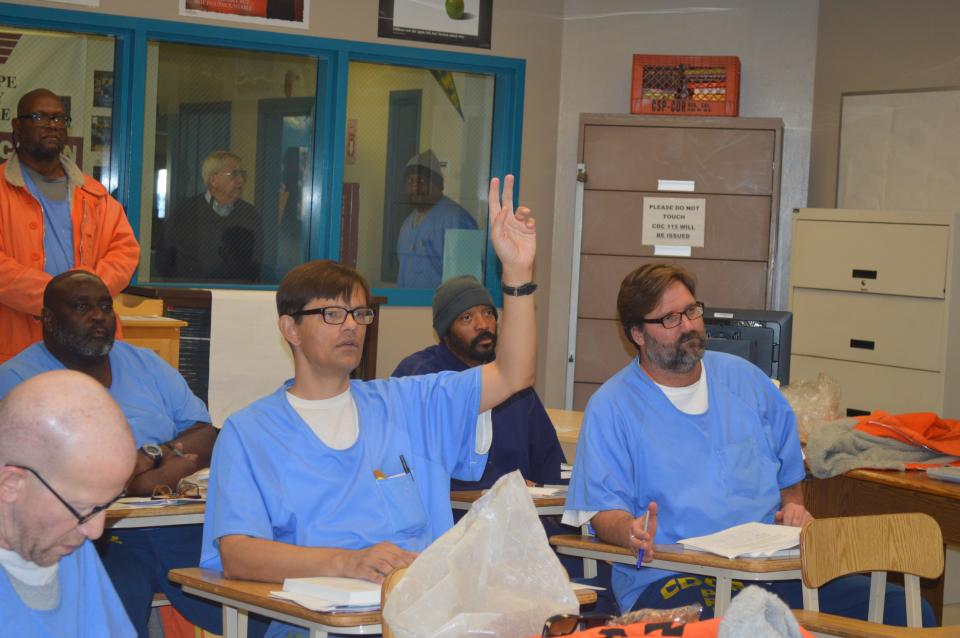Pell Grants will return to prison, but for many, college will still be out of reach
Caddell Kivett is ready to go back to college. He sorted out some old, defaulted student loans. He figured out what he wants to study. And he thought he had found a new way to pay for his classes.
Except Kivett, 52, is in prison.
He’ll be able, in theory, to use a federal Pell Grant to help pay for his education come July. It marks the first time in nearly three decades that incarcerated people – as many as 700,000 of them, according to the Education Department – are broadly eligible for the aid, and the policy change could open up new college opportunities across the country.
The expansion of Pell Grants has been a long-sought change since the 1994 crime bill eliminated them for people in prison and ended the majority of prison education programs. Although educating people in prison has been shown to have a number of benefits, the new money may be difficult for many to access for a host of reasons.
Pell Grants for prisoners: Obama to give inmates a second chance at college
In Kivett’s case, the only higher-ed option at his North Carolina facility is a theology degree. He wants to study journalism after working for the prison newspaper, the Nash News.
And he learned a harsh reality after months of phone calls and letters to colleges that offer accredited, paper-based correspondence courses: The federal aid can be used only at prisons that have Pell-eligible college programs. His doesn’t.
Studies show that prison education increases the chance of someone getting a job after release and decreases the likelihood that they’ll go back to prison. Providing education to those who won’t ever go home has benefits, too. Lifers often become mentors to others, which helps create a more positive prison culture. Pell Grants are the main form of federal financial aid for low-income students, which includes most incarcerated learners, providing a maximum annual award of $7,395.

Many prisons lack college access
But Pell funds won’t be enough to suddenly make college available to everyone like Kivett. Basic information gaps need to be filled, college support structures need to be built, and departments of correction need to sort out their new role in all of this. Congress assigned them the task of approving new prison education programs.
That raises questions about how programs are assessed and who ensures they are actually meeting students’ needs. And it means opportunities will vary widely by state. Right now, incarcerated people in fewer than a third of state and federal prisons have access to postsecondary education, and much of what is offered doesn’t lead to an academic degree.
Places like California that draw on state funds to allow incarcerated students to take community college classes will be using Pell funding to expand bachelor’s degree programs. Some states will be starting from scratch. Others might not participate at all.
Many states, including Washington and Kansas, will be building on programs that were part of the Second Chance Pell Experiment, which offered access to federal aid for some students starting in 2015. By last year, Second Chance Pell was offered at about 200 sites and had awarded federal aid to 30,000 incarcerated students.
What is a Pell Grant? Who qualifies? What to know after Biden announces student loan plan
All of this is happening as prisons and colleges are still recovering from the COVID-19 pandemic, correctional agencies across the country are facing staff shortages, and everyone is still waiting on the final word from the Education Department on exactly how it will sign off on new programs. What it all adds up to is this: Despite the return of Pell, most incarcerated people still won’t be able to get a college education this fall.
When information is ‘next to nil’
One of the biggest challenges is information. Many potential students are eagerly awaiting the return of Pell – but understanding what that means for them is difficult. Am I eligible? How would I sign up? What strings are attached? And where can I find out more?
There are a lot of basics that people don’t know: Pell can’t be used for graduate school or by people who have already finished a bachelor’s degree, for example, and there’s a lifetime limit of 12 semesters for eligibility.
“People need to be able to make informed choices about Pell dollars. That's your money as a student, and that's being used on your behalf,” said Stephanie Gaskill, a fellow at the Jesuit Social Research Institute at Loyola University New Orleans. She assists with the institute’s higher education in prison program and is a member of the Pell Is Not Enough research team at the University of Utah.
“It's a responsibility for those of us helping to bring programs in to make sure that people are making informed decisions. Those may be limited choices, but people need to have information in order to make those choices for themselves.”

For now, the confusion seems ubiquitous. “The word around here on Pell is next to nil,” said Quadaire Patterson, 34, who is incarcerated in Virginia and runs a website, Brilliance Behind Bars, with the help of his fiancee. “There has not been one whisper of any upcoming higher education programs that will utilize Pell Grant funds.”
Opinion: Why providing Pell Grants for prison inmates is a sound investment
Because people know he’s active in criminal justice reform, inmates often ask Patterson about how they can tap into the federal money. He has to tell them that they can’t just sign up, that there has to be a Pell-eligible program at their prison. “The looks on their faces show so much despair.”
Patterson has paid out of pocket to take a few college classes in social sciences and is now taking a paralegal course with the goal of becoming a lawyer. “What I've learned is that being incarcerated presents a critical, daily ultimatum,” he said. “Will we choose to actively better ourselves or passively ‘do time’?”
Another barrier is access. In many places the demand for seats way outstrips supply, and waiting lists often run a year or more. Even in places that do have college programs, people might still be excluded because of their sentence or conviction.
The legislation that restored Pell Grants for people in prison removed any federal barriers to eligibility related to how long people’s sentences are or their specific crimes, but states still have broad discretion in who can take classes behind bars. Half of the states impose restrictions on participation in education based on the length of a person's sentence, according to the Council of State Governments Justice Center.
'You don't know what you did for me': Released from prison by Obama, now on the dean's list
When Jevon Jackson, 45, who is incarcerated in Wisconsin, heard Pell was returning, he thought that would mean “the educational floodgates will open.” He had been at two facilities with Second Chance programs but had been excluded because of his life sentence.

Jackson always loved school as a kid, but he was locked up at age 16 and was able to get only his GED. Twenty years ago, he took a few correspondence courses that were paid for by an outside sponsor. Now he wants to study counseling and creative writing. But the return of Pell, it turns out, has not changed much about his chances at college for now.
Pell is first being offered to short-timers, he said education staff told him. They will expand opportunities to people with lengthier sentences only “when more spots become available.”
He earned a full ride to college: He spent 15 years wrongly imprisoned instead.
The challenges of scaling up
So what, exactly, does it take to get a college program in prison off the ground, how will existing sites scale up, and are colleges actually ready?
One of the biggest challenges for increased capacity this fall is the tight timeline. Academic schedules are set months in advance, which ties up faculty, and other partners, such as accrediting agencies, need to sign off.
Colleges have to redesign everything, including financial aid processes and admissions applications, to operate in an environment that doesn’t often have internet access. Keramet Reiter, for example, had to create a paper-based application for people who wanted to apply to the University of California system’s first bachelor’s degree program for incarcerated students.
Reiter, a criminology professor who directs the program, and another staff member at the Irvine campus took screenshots of the undergraduate application for the University of California, printed them, took them in person to potential students, had them fill them out, and entered them into the application system. “There's four application essays, so I typed all 120 of them for our 30 applicants,” she said. “It’s a nightmare.”
Gaskill, the Loyola researcher, said colleges starting new programs also need to realize that students inside don’t have direct access to the things they would on campus. “As a person who runs a program, you're a conduit for them to all the resources of the university,” she said.
Many existing programs will have difficulties scaling up because they often are run by a single person, she added, and there can be a cost barrier. Pell coming back is essential for many programs to get off the ground, but it doesn’t always cover the full cost of attendance. Colleges have to be prepared to absorb unexpected costs such as transcript fees and past due balances from students’ previous college experience.
Opinion: Why liberal arts education for prison inmates is a sound investment
Starting small
Ultimately, only about 2% of the state and federal prison population – about 1.3 million people – is projected to participate in higher ed programs this fall, according to estimates by the Education Department and the Vera Institute, a nonprofit group providing technical assistance to prison education programs.
In the short term, Margaret diZerega, director of Vera’s Unlocking Potential Initiative, says she expects college access to remain relatively restricted, given staffing shortages, a lack of facility space for classes, and slow adoption of technology. Given that, she says, getting even 10% of the prison population enrolled in the coming years would be a good goal.
Student debt: Democrats reintroduce bill to keep spotlight on Biden loan forgiveness plan
In recent years, changes to federal policies have removed some barriers to federal aid that will help people in prison. The same 2020 legislation that reinstated Pell Grants in prisons also restored eligibility for people with drug convictions and men who had failed to register for the Selective Service. The Education Department has also remedied another major obstacle to accessing Pell – defaulted student loans – with its “fresh start” initiative that was launched in April 2022.
Corrections officials and educators say the best approach to broadening college access in prison is slow and steady. Even in states that already have significant experience with prison education, there will be some facilities that have never had higher education and some colleges that have never operated in a prison.
“Sometimes we think that something is better than nothing, and I just don't know that that's completely true,” Gaskill said. “Sometimes, especially if you're asking people to spend their Pell dollars, you want to make sure that what you're offering is actually a good experience for students.”
How much will this help college students? The Pell Grant amount will rise by $500 in 2023.
Charlotte West covers the future of postsecondary education in prisons for Open Campus, a nonprofit newsroom focused on higher education. Sign up for her newsletter, College Inside.
This article originally appeared on USA TODAY: Pell Grants return to prison as student debt debate hangs over the US

